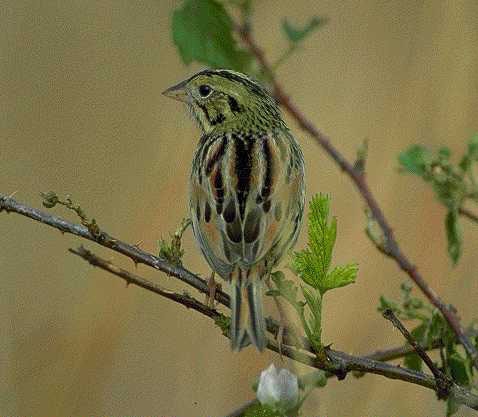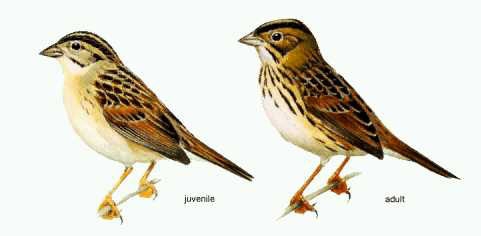Plants and Animals
Centronyx henslowii Henslow's sparrow
Key Characteristics
The Henslow's sparrow is among the smallest of sparrows at 4-5.25 in. (10-13 cm) in length. The large flat head, large gray bill and short tail are characteristic with the head, nape, and most of the central crown stripe are olive-colored. The wings are a dark chestnut color and the breast has fine streaks and the olive head and chestnut wings are diagnostic. Due to its timid nature, Henslow's Sparrows are more likely to be heard than seen. It has an ordinary, two-syllable song that is quite weak and fine, often represented as "tsee-wick" or "tsee-lick".
Status and Rank
US Status: No Status/Not Listed
State Status: E - Endangered (legally protected)
Global Rank: G4 - Apparently secure
State Rank: S3 - Vulnerable
Occurrences
| County | Number of Occurrences | Year Last Observed |
|---|---|---|
| Allegan | 2 | 2022 |
| Alpena | 1 | 2006 |
| Barry | 9 | 2015 |
| Bay | 1 | 2007 |
| Berrien | 8 | 2020 |
| Branch | 4 | 2007 |
| Calhoun | 2 | 2007 |
| Cass | 1 | 2015 |
| Clinton | 2 | 2007 |
| Eaton | 1 | 2007 |
| Genesee | 1 | 2004 |
| Gladwin | 1 | 2007 |
| Gratiot | 2 | 2007 |
| Hillsdale | 2 | 2006 |
| Huron | 1 | 2022 |
| Ingham | 3 | 2015 |
| Ionia | 3 | 2007 |
| Isabella | 2 | 2006 |
| Jackson | 6 | 2022 |
| Kalamazoo | 6 | 2022 |
| Lake | 1 | 2007 |
| Lenawee | 2 | 2015 |
| Livingston | 3 | 2006 |
| Mason | 1 | 2006 |
| Montcalm | 2 | 2007 |
| Muskegon | 1 | 2002 |
| Oakland | 2 | 2007 |
| Osceola | 2 | 2014 |
| Roscommon | 1 | 2007 |
| Saginaw | 1 | 2007 |
| Sanilac | 2 | 2004 |
| St. Clair | 1 | 2006 |
| Tuscola | 1 | 2006 |
| Van Buren | 3 | 2007 |
| Washtenaw | 6 | 2023 |
| Wayne | 4 | 2007 |
Information is summarized from MNFI's database of rare species and community occurrences. Data may not reflect true distribution since much of the state has not been thoroughly surveyed.
Habitat
The Henslow's sparrow can be found in a variety of old field and pasture habitats such as weedy or grassy fields and meadows often in low-lying or damp areas with widely scattered shrubs. Some studies have shown a decided preference for tall and dense grass cover and a high density of standing dead vegetation.
Natural Community Types
For each species, lists of natural communities were derived from review of the nearly 6,500 element occurrences in the MNFI database, in addition to herbarium label data for some taxa. In most cases, at least one specimen record exists for each listed natural community. For certain taxa, especially poorly collected or extirpated species of prairie and savanna habitats, natural community lists were derived from inferences from collection sites and habitat preferences in immediately adjacent states (particularly Indiana and Illinois). Natural communities are not listed for those species documented only from altered or ruderal habitats in Michigan, especially for taxa that occur in a variety of habitats outside of the state.
Natural communities are not listed in order of frequency of occurrence, but are rather derived from the full set of natural communities, organized by Ecological Group. In many cases, the general habitat descriptions should provide greater clarity and direction to the surveyor. In future versions of the Rare Species Explorer, we hope to incorporate natural community fidelity ranks for each taxon.
Management Recommendations
Three of the most frequently recommended management tools are burning, mowing, and grazing. Periodic burning is necessary to remove encroaching woody vegetation and maintain natural grasslands. However, prescribed burns of Henslow's sparrow habitat should be scheduled in late fall (October and November) in order to keep the burn from affecting the breeding season and allow dense vegetation regrowth to occur without delaying the following nesting season. Also, entire areas of suitable habitat should not be burned in one season, but rather a rotational burn disturbance regime should be implemented where possible. Henslow's sparrows have used hayfields repeatedly if mowing is restricted to after the end of the nesting season to avoid destruction of nests, eggs, and young. Grazing is an alternative to mowing that reduces the threat of nest destruction and prevents succession to shrubby or forested conditions but grazing pressure should be limited. Another management recommendation is to provide >75 acres of contiguous grassland if possible. Otherwise, provide a complex of small units located near each other to allow for recolonization. Restricting the use of insecticides within suitable Henslow's sparrow habitat will protect the prey base the bird rely on.
Active Period
Migration from second week of April to third week of May
Migration from third week of September to third week of October
Nesting from fourth week of April to fourth week of August
Survey Methods
Transects through potential habitat just after sunrise is the best way to detect singing male Henslow's sparrows on territory.
Transects
Survey Period: From first week of May to first week of July
Time of Day: Morning (sunrise)
References
Survey References
- Bibby, C.J., N.D. Burgess, and D.A. Hill. 1992. Bird Census Techniques. Academic Press, New York.
Technical References
- Currier, C. 2001. Special Animal Abstract for Ammodramus henslowii (Henslow’s sparrow). Michigan Natural Features Inventory, Lansing, MI. 5pp.
- Rising, J.D. 1996. A Guide to the Identification and Natural History of the Sparrows of the United States and Canada. Academic Press. 365pp.



